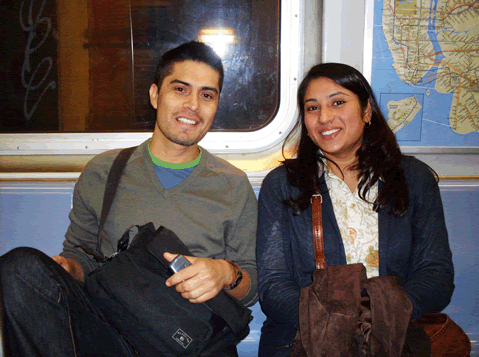acts of translation in the academy and across national boundaries
Gail E. Hawisher, Patrick W. Berry, Cynthia L. Selfe, Vanessa Rouillon, Ismael Gonzalez, and Hannah Kyung Lee
Click on image to see the many ways Ismael represents himself on Facebook.
-
Home
-
Introduction
-
Chapter 1: Digital Literacies, Technological Diffusion, and Globalization
-
Chapter 2: Digital Media & Transnational Connections: From Sarajevo, Bosnia-Herzegovina, and Sydney, Australia
-
Chapter 3: Cultural Designs for Writing Digitally: From Urbana, Illinois, and Afar
-
Chapter 4: Acts of Translation in the Academy and Across National Boundaries
-
Chapter 5: Global Digital Divide: From Nigeria and the People's Republic of China
-
Conclusion
-
Resources
CHAPTER 4: Ismael Gonzalez
Turning to Ismael, who was born in Ocotepec, Mexico, in 1979, we first encounter his video, titled “Writing: Pain or Joy?”

Click on image to view Ismael's movie: “Writing: Pain or Joy?”
In Ismael’s writing process video, we see Ismael going about his everyday university life. The sun rises as he prepares breakfast, and we see him washing dishes piled in his sink. He turns toward the frying pan to cook and then, presumably after breakfast, connects his laptop. At some point, he realizes that he needs to check out additional books and heads off to the University of Illinois library before returning to his writing. We watch as he first seeks out Google and then begins an academic paper on “Computers, Humans and Conversation.” He reads another paper and, then, still in his college office, finds time to nap—propped up on a pillow in front of his laptop and library book. The following morning we glimpse the Illinois quad and watch him write and edit, pen in hand, as he also eats the breakfast he’s prepared of scrambled eggs, tortillas, and black beans. A long-emerging sentence, the taking of medication, and a telephone call are followed by Ismael’s working and talking about writing with one of his students in a computer classroom. But always there—sometimes in the background—is the paper and its many drafts in various states of completion. We see a mechanical timer representing his deadline, the English Building where he will submit his writing, and, finally, his movie credits and a thank-you to his classmates and instructor. Ismael depicts in his video a bit of his day-to-day living on the Illinois campus, a life of writing, teaching, and study that—at least on the screen—looks remarkably similar to that of the United States–born graduate students in his class.
Ismael's and Vanessa's videos share many similarities with the videos of the other coauthors in our larger study. The two populate their writing spaces with images, food, objects, and music that hail not only from their home countries but also from the United States. Artifacts of sound that may comfort them as they immerse themselves in writing include Ismael’s “Somnambulist” by BT and “Bohemia After Dark” by Cannonball Adderly, the latter a part of the American tradition of jazz that has spread itself over cultural settings around the world; the Italian Vivaldi’s violin concertos that Vanessa plays have similarly become global in their reach. Mixed with these sound artifacts are place markers from the new locations in which they have dwelled, including the University of Illinois landscape and academic buildings in Ismael's video and the window view of the pond and condominium complex in Champaign, Illinois, in Vanessa's.
What we don’t see explicitly in Ismael’s video, however, is the discomfort Ismael sometimes experienced as a Latino in class and on campus; nor do we hear the striking information he offered in his writing responses to the semester’s readings and class discussions. After reading Victor Villanueva's (1999) College Composition and Communication piece “On the Rhetoric and Precedents of Racism,” for example, Ismael wrote:
"Being Mexican, I share Villanueva's sentiment expressed in his article. Although I much enjoyed reading his Incan and Aztecan illustrations with which he starts, it was not an easy article to read; I had to revisit the dictionary every other time…. I wanted to know what every word would exactly convey. So, as an ESL learner, I have added a new set of vocabulary items like debauchery, lice, stench, squaws, and so on to my English repertoire. I had no idea of the many adjectives which people can use to reflect their own ignorance in trying to define Mexicans."
Here, Ismael identifies with Villanueva as a Latino sometimes bewildered by what he rightly understands as the gringos’ ignorance. Like Susan Miller (1991), Ismael says he has come to realize that “[w]ithout 'good' stories to rely on, no minority or marginalized majority has a chance to change its status…” (p. 1). He deplores the fact that in the history of the field of writing studies, Mexicans and Mexican Americans have played a very minor role, even with notable exceptions in the writings of scholars like Susan Romano in her 2005 College English historical piece on a 16th century Mexican college and Jaime Mejía's questioning of the the field's representations of ethnic minorities in Crossing Borderlands (2004). Ismael then proceeds to quote from Villanueva (1999) as he agrees that “we must break from the colonial mindset and learn from the thinkers of our own hemisphere” (p. 659).
Ismael Gonzalez, Long Beach, NY
Missing from the video, however, is the recognition of Ismael’s own biases and prejudices when it comes to matters of language. He writes of himself:
"I lived in NYC for nearly two years, and I remember the first vez /ve:s/ when I heard some Hispanic gente /hende/ speak like asi /a:si/: Spanglish. My first reaction to those Chicano youths was of disapproval and rejection for not being able to articulate properly in either language, Spanish or English. Shortly after, I realized that this was in fact their language. They were sometimes not able to discern where one language started and when the other ended. It was a linear speech. I also noticed that they lived somewhere between two worlds, two languages, two realities."
Here he plays with an attempt at rendering a bit of language in Spanglish but quickly returns to the academic English he is attempting to master. In some respects, Ismael and Vanessa seem to share similar attitudes toward the English language at least insofar as their determination to learn the discourse of the academy and their penchant for keeping Spanish and English separate. At the same time, however, Ismael seems to be coming to an awareness that Spanglish might well occupy a valid place in people’s lives even though he would have difficulty regarding it as a fully developed language. He still considers Spanglish, like the lives of those who speak it, as representing two separate worlds and “two realities.” As Vanessa succinctly noted, both English and Spanish are integral to her literate life, but “one hardly ever crosses the other.”
Just as the English language was an essential component of Vanessa’s schooling, so was it central to Ismael’s education. Ismael was part of a large Mexican family with eight children, and he regards his childhood as having been quite typical for the 1980s. Typical, that is, until Ismael’s parents, Guille and Jesus, who worked as a secretary and a truck driver “somewhere up in La Sierra Norte,” were divorced. His mother moved the family to the city of Puebla and was soon offered a position working in the American School there. As Ismael describes the move:
"I was a third grader then, and started to enjoy going to public school. However, there would be a life-turning point waiting for us. A year after we had moved to this bigger city, my mother was offered a clerical position as a secretary at the most expensive private school in town, the American School. Part of the employee benefit package was the opportunity to put her children in the school while only having to pay 10% tuition. So, my mother decided to put me and my two younger sisters, Veronica and Mina, in this new school. Not only did this new chance mean we were going back to private education, but it also meant that we would have access to bilingual English-Spanish education. That is how my two younger sisters and I ended up learning English with the children of American and other international people living in Mexico."
Ismael’s education in Mexico went on to include an undergraduate degree from Universidad de las Americas-Puebla and enabled him at 19 to spend his senior year abroad in the United States at the University of New Mexico.
Even as Ismael’s education at Puebla’s American School made possible his study of English from the time he was 10, it also extended his use of digital technology, which his father originally introduced to him as early as 1985. Ismael explains:
"Computers have always been part of my life. I remember having used a computer for the first time when I was 7. My father had bought one of those old IBM computers because he wanted his children to get literate as to the use of computers. He always believed that the future was going to be ruled by computers. So, he asked one of his friends (this engineer) to show us how to use the computer. We basically used it for school purposes then. It was not, however, until I went to the American School that I started to learn more about computers and use them more frequently for purposes other than schoolwork. Now, I just cannot see myself getting away in life without a laptop."
As with those from the United States in Literate Lives (2004), the schools and families of this study's participants frequently provided gateways through which they learned computer technology. And although English has always been the language of computers, it is for those who speak more than one language that English seems to take on increased importance in their initial learning of digital media, as was especially the case for individuals who first encountered computers in the 1990s or earlier. In other words, the learning of English and computer technology tend to go hand in hand, but the presence of English tends to be considered more important by those who do not take it for granted.
Coauthors Ismael and Shafinaz on the New York City subway
Yet Spanish is the language that Ismael teaches now in the foreign language department at Manhattan College in the United States. Along with the degrees he earned in Mexico and the United States, fluency in both Spanish and English provides an essential gateway to his position as college lecturer. While teaching in New York, he has also realized that his students appreciate his Spanish-inflected English and that Spanglish can also be useful as he negotiates the streets of New York:
"For the last two years, I have been teaching Spanish and Latino Culture at Manhattan College in Riverdale, New York. To my delight, I realize that most of my students enjoy my Latino accent in English. This, I guess, gives them a sense that they could also achieve great language proficiency in Spanish and also get communication across, even if that meant to speak with an accent. Thus, it is my belief that my own speaking with an accent somehow helps them to build their new and different identity as Spanish speakers, and it even makes them feel safe as they realize that there is nothing wrong in speaking with an accent.
I cannot see a day pass by without me using computers, websites, and other multimedia technology, either in English or Spanish. In the last couple of years, Spanish, and maybe a great deal of Spanglish, has been taking precedence over English in my everyday communication here in New York City."
Thus the politics of location, a new job, and the passage of time continually work to shape and change some of Ismael’s attitudes toward language even as he acquires new literate practices:
"Before I became a Spanish instructor, my use of computers and multimedia technology was done pretty much in English as I’d only been teaching ESL/EFL. However, nearly two years and a half ago when I began teaching Spanish, I had to start using more Spanish to search for any information concerning Spanish teaching and learning. My online search may include current literature and research on L2 Spanish acquisition, Spanish teaching methodology, online Spanish exercises for my students, and the like. One of my most used and favorite websites to teach Spanish is still YouTube. There I can find pretty much anything functional that I want to be used in the classroom."
As is true for other study participants, the range of technology Ismael uses continues to expand even as his use of language changes:
"I use Spanish to communicate with my family in Mexico. I usually use Skype or Messenger as real-time stream engines. Sometime we also use video conferencing. Also, for the last five years or so, I've been very actively utilizing the Spanish version of Facebook. I think this is a wonderful tool to keep in touch not only with relatives and friends, but also with my Spanish-speaking colleagues around the world. I should remark that, for that matter, I've had to use not only Spanish, but Spanglish, which turns out to be better in the sense of functionality. At first I was rather reluctant to use Spanglish as a means for communication. Then, shortly after I moved to the NYC area, I realized that Spanglish, as an interlanguage phenomenon, was the kind of a language a great many Latinos used as their everyday language for communication."
The Many Faces of Ismael
As the opening banner video illustrates, the social networking site Facebook has become a tool that enables Ismael to bring together his family, friends, and colleagues from around the world in one space to engage in conversation and post the news of their lives using alphabetic text, photos, videos, or whatever other multimodal representation they may choose.
 |
 |
 |
 |
More images of Ismael on Facebook
The above images show the many faces of Ismael, who, along with 800 million other active users (Protalinksi, 2011), often visits Facebook, the second most popular site after Google (Kirkpatrick, 2010, p. 16). Ismael frequently updates his profile picture with images from experiences in his life such as standing, arms raised, in front of the long-defunct Parachute Jump in Coney Island or gathering with friends in Columbus Circle after the 2010 World Soccer Championship. About the latter, he wrote:
"Did you guys enjoy today's World Champion soccer game at all? Arriba Spain! Now, let's get to the pub to celebrate…gazpacho, tapas, and mojitos (not from Spain, but delicious)."
Along with these images of Ismael in various locations, we also see the word “God,” a signal of Ismael’s spiritual connection, a reference that also surfaces at the end of his writing process video. The last words read, "But most of all, God."
Early on, Facebook's creators realized that Facebook could function as a tool for conveying spiritual and political beliefs. Just a few weeks after it was created in 2004, “students began broadcasting their political opinions by replacing their profile picture with a block of text that included a political statement” (Kirkpatrick, 2010, p. 6).
Whether spiritual or political, such words and images suggest a desire to share one’s position in the world. The use of social networking sites like Facebook make such sharing much easier.
In 2006, Facebook profile updates became part of the newsfeed of user information, making staying up to date even easier. In The Facebook Effect, David Kirkpatrick (2010) tells how in 2006, just one year after Ismael composed his video, Facebook creators, astonished by the success of its photo application, began to explore how to “build a page that showed not just the latest photos your friends had added, but all the things that had recently changed on the profiles of your friends” (p. 181).
Today, Ismael, as a teacher at Manhattan College, holds a position that brings new challenges to social networking. Teachers are often advised to stay off Facebook, as Marybeth Gasman (2010) discussed in the Chronicle of Higher Education. Like TV, Gasman writes, "the newest thing for professors to 'avoid' doing is Facebook."
But Gasman, like so many other teachers, resists the pressure. Gasman explains that she likes Facebook in part because she wants her students to see her "as a real person rather than just a scholar."
Whatever its intention, however, a Facebook presence invites social interaction. As Gina Maranto and Matt Barton explain, "Regardless of their stated intentions, instructors with Facebook or MySpace profiles are indiscreetly inviting students to contact them on a social level, which some think blurs the line between acceptable communication and the actionable offense of 'conduct unbecoming' teachers. It’s putting aside that useful dichotomy of 'us and them' that so many teachers depend on for their authority in the classroom" (p. 37).
Although Facebook has gotten much attention as a place for mean-spiritedness and the attacking of teachers, it is also getting some attention as a place where teachers are praised. In a 2010 New York Times article, Susan Feinstein reported that Facebook was being used by people to connect with their old teachers, often to say thank you:
"At a time when public school teachers are being blamed for everything from poor test scores to budget crises, Facebook is one place where they are receiving adulation, albeit delayed."
Although Facebook doesn't always offer this kind of student response to instructors like Ismael, some have found it a promising teaching tool, especially when teaching another language to English speakers or, as with Ismael and Spanglish, when learning another language themselves.


